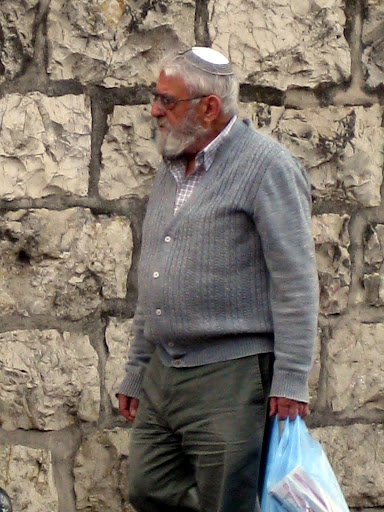A Breslover kepah, whose meaning I have explained in a previous entry.
In the world of knit kepot, size matters. A small one can say, I'm religious, but don't take it too seriously, or, my mother may make me wear a kepah, but she can't control what size I wear.
A larger kepah often indicates a more hippie/spiritual outlook on life.
Placement of the kepah also says something. Do you wear it on the back of your head (more traditional, an older look), right on the top of your head (more of a high school/college age group), or even farther forward (high school and also in the 'thinks they're cool crowd')?
Some classic knit kepot above.
I can't say for sure, but I'd be willing to bet a small amount of money that this boy's kepah was crocheted for him. Maybe by the girl he's sitting and talking with?
another classic
Blacks in Israel are usually Ethiopian. I'm not sure what their headgear was before they immigrated, but now they can be seen wearing all the modern versions, including the teeny tiny one this boy is wearing.
This man may be wearing a knit kepah, but he is ultra-orthodox, as can be easily seen from his shaved head and long peyot (side curls). Many men wear white kepot during the time between Rosh Hashana and Yom Kippur, as an expression of the purity they are trying to attain. But some wear them all year long. The pom pom on top generally indicates a particular sect or group they belong to.
The solid black knit kepah. This man is straddling worlds. He says, "I'm not quite liberal enough to wear a colorful kepah, but I'm not ready to identify with the more old fashioned society that wears black velvet or leather, either."
This man too is straddling worlds. His kepah gives a modern touch, but his black pants, white shirt, tzitzit (fringes) hanging out and being past his knees, and his peyot (side curls) tell you he's still firmly planted in the most traditional sector of society.
Another example of Ethiopian assimilation.

Kepah hanging off to the side. It might mean, "I'm too cool to worry about whether my kepah is falling over my ear." It might mean, "I'm not concerned with appearances." It might mean, "My kepah clips won't stay on."

Big purple kepah and wearing a backpack? Definite hippy.


Another version of the white knit kepah, this one sans pom pom.

This is only a taste of the knit kepah world. More to come!
